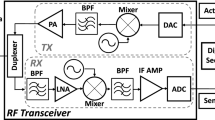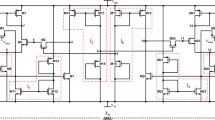Abstract
In this work, performance of conventional gyrator-C based active inductor is studied and two designs of single-ended active inductors based on modified gyrator-C topology employing SiGe HBTs are proposed using 130 nm BiCMOS technology which provides high quality factor with low-power consumption. The performance in terms of inductive bandwidth, S11, noise figure, quality factor and power consumption have been compared and the tradeoff between performance parameters are discussed. In the proposed work, first design of active inductor produces high value of inductive bandwidth (271 MHz–3.7 GHz) with moderate value of quality factor (437), whereas second design produces moderate range of inductive bandwidth (182 MHz–2.3 GHz) with high quality factor (6014). The proposed active inductors are used in second order LC band pass filter and the performance metrics of filter in terms of 1 dB compression point (− 18.88 and − 18.55), IIP3 (− 14.68 and − 9.02) and passband gain is investigated. The study suggests that proposed designs of active inductors are suitable candidate for high performance, low power RF applications with nearly 1 GHz bandwidth.












Similar content being viewed by others
References
Ou, J. (2016). Design considerations of CMOS active inductor for low power applications. In IEEE Dallas Circuits and Systems Conference (pp. 1–4). IEEE, https://doi.org/10.1109/DCAS.2016.7791121
Sy, C. H., Bosse, S., Barth, S., & Harison, S. R. (2015). Design of a differential diplexer based on integrated active inductors with 0.25 µm SiGeC process. In 2015 European Microwave Conference (EuMC) (pp. 893–896). IEEE, https://doi.org/10.1109/EuMC.2015.7345908
Atef, M., & Abd-Elrahman, D. (2014). 2.5 Gbit/s compact transimpedance amplifier using active inductor in 130nm CMOS technology. In International Conference on Mixed Design of Integrated Circuits and Systems (pp. 103–107). IEEE, https://doi.org/10.1109/MIXDES.2014.6872165
Ma, L., Wang, Z. G., Xu, J., & Amin, N. M. (2017). A high-linearity wideband common-gate LNA with a differential active inductor. IEEE Transactions on Circuits and Systems II: Express Briefs, 64(4), 402–406. https://doi.org/10.1109/TCSII.2016.2572201
Kia, H. B., & A’ain, A. K. (2014). A wide tuning range voltage controlled oscillator with a high tunable active inductor. Wireless Personal Communications, 79(1), 31–41. https://doi.org/10.1007/s11277-014-1839-3
Huang, G., & Kim, B.-S. (2008). Programmable active inductor-based wideband VCO/QVCO design. IET Microwaves, Antennas and Propagation, 2(8), 830–838. https://doi.org/10.1049/iet-map:20070340
Ben Hammadi, A., Mhiri, M., Haddad, F., Saad, S., & Besbes, K. (2016). A 1.82–4.44 GHz reconfigurable bandpass filter based on tunable active inductor. In International Design and Test Workshop (Vol. 0, pp. 254–259). IEEE Computer Society. https://doi.org/10.1109/IDT.2016.7843050
Xiao, H., Schaumann, R., Daasch, W. R., Wong, P. K., & Pejcinovic, B. (2004). A radio-frequency CMOS active inductor and its application in designing high-Q filters. In 2004 IEEE International Symposium on Circuits and Systems (pp. 197–200). IEEE. https://doi.org/10.1109/ISCAS.2004.1328974
Krishnamurthy, S. V., El-Sankary, K., & El-Masry, E. (2010). Noise-cancelling CMOS active inductor and its application in RF band-pass filter design. International Journal of Microwave Science and Technology, 2010, 1–8. https://doi.org/10.1155/2010/980957
Manjula, J., & Malarvizhi, S. (2014). Performance analysis of a low power low noise tunable band pass filter for multiband RF front end. Journal of Semiconductors, 35(3), 035001. https://doi.org/10.1088/1674-4926/35/3/035001
Heydarzadeh, S., & Torkzadeh, P. (2013). 1 GHz CMOS band-pass filter design using an active inductor and capacitor. American Journal of Electrical and Electronic Engineering, 1(3), 37–41. https://doi.org/10.12691/ajeee-1-3-1
Liang, K. H., Ho, C.-C., Kuo, C. W., & Chan, Y. J. (2005). CMOS RF band-pass filter design using the high quality active inductor. IEICE Transactions on Electronics, 88, 2372–2375. https://doi.org/10.1093/ietele/e88-c.12.2372
Choi, Y. W., & Luong, H. C. (2001). A high-Q and wide-dynamic-range 70 MHz CMOS bandpass filter for wireless receivers. IEEE Transactions on Circuits and Systems II: Analog and Digital Signal Processing, 48(5), 433–440. https://doi.org/10.1109/82.938353
Yue, Wu., Ding, X., Ismail, M., & Olsson, H. (2003). RF bandpass filter design based on CMOS active inductors. IEEE Transactions on Circuits and Systems II: Analog and Digital Signal Processing, 50(12), 942–949. https://doi.org/10.1109/TCSII.2003.820235
Selvathi, D., & Pown, M. (2015). Design of Band Pass Filter using active inductor for RF receiver front-end. In International Conference on Communication and Network Technologies (Vol. 2015-March, pp. 296–301). IEEE, https://doi.org/10.1109/CNT.2014.7062773
Sachan, D., Goswami, M., & Misra, P. K. (2018). A high-Q floating active inductor using 130 nm BiCMOS technology and its application in IF band pass filter. Analog Integrated Circuits and Signal Processing. https://doi.org/10.1007/s10470-018-1196-3
Kostack, R., Naeini, A., Stockinger, H., Bronner, A., & Ellinger, F. (2017). A direct RF sampling receiver using continuous-time band-pass sigma-delta ADC with active inductor in CMOS. In IEEE MTT-S Latin America Microwave Conference (pp. 1–4). IEEE, https://doi.org/10.1109/LAMC.2016.7851261
Li, C., Gong, F., & Wang, P. (2010). Analysis and design of a high-Q differential active inductor with wide tuning range. IET Circuits Devices and Systems, 4(6), 486. https://doi.org/10.1049/iet-cds.2010.0011
Thanachayanont, A., & Payne, A. (1996). VHF CMOS integrated active inductor. Electronics Letters, 32(11), 999–1000. https://doi.org/10.1049/el:19960669
Akbari-Dilmaghani, R., Payne, A., & Toumazou, C. (1998). High Q RF CMOS differential active inductor. Proceedings of the IEEE International Conference on Electronics, Circuits, and Systems, 3, 157–160. https://doi.org/10.1109/icecs.1998.813957
Thanachayanont, A. (2002). CMOS transistor-only active inductor for IF/RF applications. In International Conference on Industrial Technology (Vol. 2, pp. 1209–1212). IEEE, https://doi.org/10.1109/ICIT.2002.1189346
Yuan, F. (2008). CMOS Active Inductors and Transformers. Springer. https://doi.org/10.1007/978-0-387-76479-5
Hsiao, C.-C., Kuo, C.-W., Ho, C.-C., & Chan, Y.-J. (2002). Improved quality-factor of 0.18-um CMOS active inductor by a feedback resistance design. IEEE Microwave and Wireless Components Letters, 12(12), 467–469. https://doi.org/10.1109/LMWC.2002.805931
Crols, J., & Steyaert, M. S. J. (1998). Low-IF topologies for high-performance analog front ends of fully integrated receivers. IEEE Transactions on Circuits and Systems II: Analog and Digital Signal Processing, 45(3), 269–282. https://doi.org/10.1109/82.664233
Funding
Not Applicable.
Author information
Authors and Affiliations
Corresponding author
Ethics declarations
Conflict of interest
All authors declare that they have no conflict of interest.
Additional information
Publisher's Note
Springer Nature remains neutral with regard to jurisdictional claims in published maps and institutional affiliations.
Rights and permissions
About this article
Cite this article
Sachan, D., Goswami, M. & Misra, P.K. Design of Ultra-Low Power High-Q Single Ended Active Inductors for IF BPF of Receiver Frontend Using 130 nm BiCMOS Technology. Wireless Pers Commun 120, 649–663 (2021). https://doi.org/10.1007/s11277-021-08483-3
Accepted:
Published:
Issue Date:
DOI: https://doi.org/10.1007/s11277-021-08483-3




